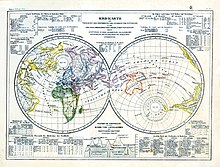Land hemisphere
![]()
This article or subsequent section is not sufficiently supported by evidence (e.g., anecdotal evidence). Information without sufficient evidence may be removed in the near future. Please help Wikipedia by researching the information and adding good supporting evidence.
completely unsprung
The land hemisphere or land hemisphere is the hemisphere of the Earth's globe that (mathematically determined) has the largest proportion of land.
Its center is at 47° 13′ N, 1° 32′ W47.2166666667-1.53333333333 in the French city of Nantes in the Pays de la Loire region. According to an earlier calculation, the center is at 47° 25′ N, 2° 37′ W47.411666666667-2.62027777778 near the island of Dumet, about 6 km off the French Atlantic coast at the village of Piriac-sur-Mer, northwest of the mouth of the Loire River. The land hemisphere includes all of Europe, Africa, North America, and Greenland, about 95 percent of Asia (except for Far Eastern coastal zones), and two-thirds of South America.
Nearly 6/7 (85.6%) of the Earth's land area is in the land hemisphere, which in turn has 53 percent of its surface covered by water and 47 percent by land. Thus, water predominates even in the hemisphere with the largest proportion of land.
Globally, it is 71 percent water and 29 percent land.
The contrarian water hemisphere (with the minimal land portion) is centered in the southwestern Pacific Ocean, near the Bounty Islands of New Zealand.

Land hemisphere (53% water, 47% land)

True-surface azimuthal projection of the land hemisphere (with projection center on the prime meridian at 50° N, in the English Channel)

Earth map of 1849 with the hemisphere of the largest mass of land (left) and the hemisphere of the largest mass of water (right)
Search within the encyclopedia